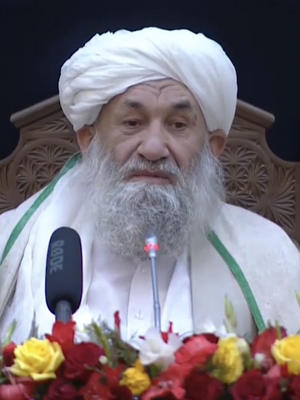Prime Minister of Afghanistan facts for kids
Quick facts for kids Prime Minister of the Islamic Emirate of Afghanistan |
|
|---|---|
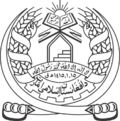
|
|
| Government of Afghanistan | |
| Member of | Cabinet |
| Reports to | Leadership |
| Seat | Kabul |
| Appointer | Supreme Leader |
| Term length | At the pleasure of the supreme leader |
| Constituting instrument | 1998 dastur |
| Formation |
|
| First holder | Shir Ahmad |
| Succession | No (Deputy Leader succeeds Supreme Leader) |
| Deputy | Deputy Prime Minister |
| Salary | ؋198,250 monthly |
The prime minister of Afghanistan is the main leader of the government in Afghanistan. This important role is officially called the prime minister of the Islamic Emirate of Afghanistan.
The position was first created in 1927. At that time, the king of Afghanistan chose the prime minister. For many years, the prime minister mostly gave advice to the king. This changed after the Kingdom of Afghanistan ended in 1973.
In the 1980s, the prime minister became the actual head of the government. However, the role was removed after the US invasion in 2001. Afghanistan then had a president as its main leader until 2021.
After the US troops left and the Taliban took control again, the job of prime minister was brought back. On September 7, 2021, Hasan Akhund was named the acting prime minister. He leads the new temporary government of the Islamic Emirate of Afghanistan. The prime minister and the government follow the instructions of the supreme leader.
Contents
History of the Prime Minister Role
The Kingdom Era (1927–1973)
In the early days, the king was the main leader of the Council of Ministers. The prime minister only took charge if the king was away.
Until 1963, King Mohammad Zahir Shah chose his own family members to be prime ministers. The king could also fire them. But in 1963, things changed. The new rules said that the prime minister would be the head of the Afghan government. The government would be made up of its ministers. This was the first time the king had less direct power over the government. The prime minister and ministers were expected to focus only on their government jobs.
The 1964 Constitution also gave the prime minister the power to call a special group of leaders if the king died. The prime minister was responsible to the lower house of the Parliament, called the Wolesi Jirga. They had to explain the government's plans and their own duties.
The Democratic Republic Era (1978–1992)
In April 1978, a major change happened in Afghanistan. The People's Democratic Party of Afghanistan (PDPA) brought back the prime minister's job. This role continued through the 1980s.
The president chose the prime minister. The prime minister then chose the Council of Ministers. This Council was in charge of making and carrying out plans for the country. They also created economic plans and made sure there was public order.
Under the 1987 Constitution, the president had to appoint a prime minister to form the government. The prime minister could also dissolve, or end, the government. During this time, some presidents also held the job of prime minister. However, after the Soviet Union entered Afghanistan, the prime minister had less power. Other leaders, like the head of the PDPA, became more powerful.
The 1990 Constitution added a new rule. It said that only people born in Afghanistan could be prime minister. This rule was not in earlier documents.
The Islamic State Era (1992–1996)
After the government of Mohammad Najibullah fell, a temporary government was set up. The prime minister's role became important again.
During this time, there were often disagreements between the president and the prime minister. The country's central government was not very strong from 1992 to 1996. Because of this, the prime minister's job became more of a symbolic role, with little real power.
The Islamic Emirate Era (1996–2001, 2021–Present)
The title of prime minister was removed when the Taliban took control in 1996. During their rule, the deputy leader of the Taliban was often called the prime minister. After Mohammad Rabbani died in 2001, the Taliban decided not to bring the job back.
The government that the Taliban had removed continued to have a prime minister until September 1997. This government was in rebellion until the Taliban's rule ended in 2001.
On September 7, 2021, the Taliban brought back the position of prime minister.
List of Prime Ministers
(Dates in italic mean the person continued in office even if the situation changed)
| Name | Portrait | Lifespan | Time in Office | Political Group | |||
|---|---|---|---|---|---|---|---|
| Started | Ended | Length of Time | |||||
| Kingdom of Afghanistan (1926–1973) | |||||||
| Shir Ahmad |  |
c. 1885–? | 25 October 1927 | January 1929 | 1 year, 2 months | Independent | |
| Prime Minister; Removed from office. | |||||||
| Shir Giyan |  |
died 1929 | January 1929 | 1 November 1929 | 10 months | Independent | |
| Prime Minister; Removed from office. | |||||||
| Mohammad Hashim Khan | 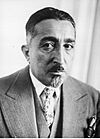 |
1884–1953 | 1 November 1929 | 9 May 1946 | 16 years, 189 days | Independent | |
| Prime Minister; From the Barakzai dynasty royal family. | |||||||
| Amanat Lewana |  |
Unknown | c. 1944 | c. 1946 | c. 2 years | Unknown | |
| Prime Minister under a rebel king Salemai; Only controlled the Eastern Province during tribal revolts. | |||||||
| Shah Mahmud Khan | 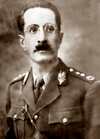 |
1890–1959 | 9 May 1946 | 7 September 1953 | 7 years, 121 days | Independent | |
| Prime Minister; From the Barakzai dynasty royal family. | |||||||
| Mohammad Daoud Khan | 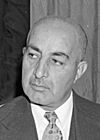 |
1909–1978 | 7 September 1953 | 10 March 1963 | 9 years, 184 days | Independent | |
| Prime Minister; From the Barakzai dynasty royal family. | |||||||
| Mohammad Yusuf |  |
1917–1998 | 10 March 1963 | 2 November 1965 | 2 years, 237 days | Independent | |
| Prime Minister. | |||||||
| Mohammad Hashim Maiwandwal |  |
1919–1973 | 2 November 1965 | 11 October 1967 | 1 year, 343 days | Independent (until 1966) |
|
| Progressive Democratic Party | |||||||
| Prime Minister. | |||||||
| Abdullah Yaqta |  |
1914–2003 | 11 October 1967 | 1 November 1967 | 21 days | Independent | |
| Acting Prime Minister. | |||||||
| Mohammad Nur Ahmad Etemadi |  |
1921–1979 | 1 November 1967 | 9 June 1971 | 3 years, 220 days | Independent | |
| Prime Minister. | |||||||
| Abdul Zahir | 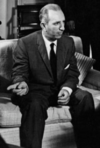 |
1910–1982 | 9 June 1971 | 12 November 1972 | 1 year, 156 days | Independent | |
| Prime Minister. | |||||||
| Mohammad Musa Shafiq |  |
1932–1979 | 12 November 1972 | 17 July 1973 | 247 days | Independent | |
| Prime Minister; Removed from office during a coup d'état. | |||||||
| Job removed (17 July 1973 – 1 May 1978) | |||||||
| Democratic Republic of Afghanistan (1978–1992) | |||||||
| Nur Muhammad Taraki |  |
1917–1979 | 1 May 1978 | 27 March 1979 | 330 days | People's Democratic Party (Khalq group) |
|
| Chairman of the Council of Ministers. | |||||||
| Hafizullah Amin |  |
1929–1979 | 27 March 1979 | 27 December 1979 | 275 days | People's Democratic Party (Khalq group) |
|
| Chairman of the Council of Ministers; Killed by Soviet special forces. | |||||||
| Babrak Karmal |  |
1929–1996 | 27 December 1979 | 11 June 1981 | 1 year, 166 days | People's Democratic Party (Parcham group) |
|
| Chairman of the Council of Ministers. | |||||||
| Sultan Ali Keshtmand |  |
born 1935 | 11 June 1981 | 26 May 1988 | 6 years, 350 days | People's Democratic Party (Parcham group) |
|
| Chairman of the Council of Ministers; First time in office. | |||||||
| Mohammad Hasan Sharq |  |
born 1925 | 26 May 1988 | 21 February 1989 | 271 days | Independent | |
| Chairman of the Council of Ministers; Appointed as part of a peace effort. | |||||||
| Sultan Ali Keshtmand |  |
born 1935 | 21 February 1989 | 8 May 1990 | 1 year, 76 days | People's Democratic Party (Parcham group) |
|
| Chairman of the Council of Ministers; Second time in office. | |||||||
| Fazal Haq Khaliqyar |  |
1934–2004 | 8 May 1990 | 15 April 1992 | 1 year, 343 days | People's Democratic Party (Parcham group) (until June 1990) |
|
| Homeland Party | |||||||
| Chairman of the Council of Ministers; Resigned from office. | |||||||
| Islamic State of Afghanistan (1992–2002) | |||||||
| Abdul Sabur Farid Kohistani |  |
1952–2007 | 6 July 1992 | 15 August 1992 | 40 days | Hezb-e Islami Gulbuddin | |
| Prime Minister. | |||||||
| Job empty (15 August 1992 – 17 June 1993) | |||||||
| Gulbuddin Hekmatyar |  |
born 1947 | 17 June 1993 | 28 June 1994 | 1 year, 11 days | Hezb-e Islami Gulbuddin | |
| Prime Minister; First time in office. | |||||||
| Arsala Rahmani Daulat |  |
1937–2012 | 28 June 1994 | 1995 | ≈ 1 year | Ittehad-e Islami | |
| Acting Prime Minister. | |||||||
| Ahmad Shah Ahmadzai |  |
1944–2021 | 1995 | 26 June 1996 | ≈ 1 year | Ittehad-e Islami | |
| Acting Prime Minister. | |||||||
| Gulbuddin Hekmatyar |  |
born 1947 | 26 June 1996 | 11 August 1997 | 1 year, 46 days | Hezb-e Islami Gulbuddin | |
| Prime Minister; Second time in office; Left Kabul after the Taliban took control in September 1996; Continued to serve as Prime Minister in areas controlled by the Northern Alliance during the Civil War; The Islamic State was still seen as the official government by other countries, even though it controlled only a small part of Afghanistan. | |||||||
| Abdul Rahim Ghafoorzai |  |
1947–1997 | 11 August 1997 | 21 August 1997 | 10 days | Independent | |
| Prime Minister; Served only in areas controlled by the Northern Alliance during the Civil War; The Islamic State was still seen as the official government by other countries; Died in a plane crash. | |||||||
| Islamic Emirate of Afghanistan (1996–2001) | |||||||
| Mullah Mohammad Rabbani |
 |
1955–2001 | 27 September 1996 | 13 April 2001 | 4 years, 198 days | Taliban | |
| Deputy Head of the Supreme Council; Prime Minister; Also a deputy leader of the Taliban; Died while in office; The Islamic Emirate was not widely recognized by other countries, even though it controlled most of Afghanistan. | |||||||
| Mawlawi Abdul Kabir |
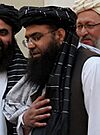 |
born 1958 | 16 April 2001 | 13 November 2001 | 211 days | Taliban | |
| Acting Deputy Head of the Supreme Council; Acting Prime Minister; Removed from office when Kabul fell. | |||||||
| Job removed (13 November 2001 – 7 September 2021) | |||||||
| Islamic Emirate of Afghanistan (2021–present) | |||||||
| Mullah Hasan Akhund |
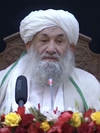 |
between 1945 and 1958 | 7 September 2021 | Currently in office | 4 years, 102 days | Taliban | |
| Acting Prime Minister; The Islamic Emirate is not currently recognized by other countries, even though it controls all of Afghanistan. Hasan Akhund was recovering from an illness from May 17 to July 17, 2023, during which his deputy Abdul Kabir took over his duties. | |||||||
| Mawlawi Abdul Kabir |
 |
born 1958 | 17 May 2023 | 17 July 2023 | 61 days | Taliban | |
| Acting Prime Minister for a short time while Hasan Akhund was sick. | |||||||
Timeline of Prime Ministers
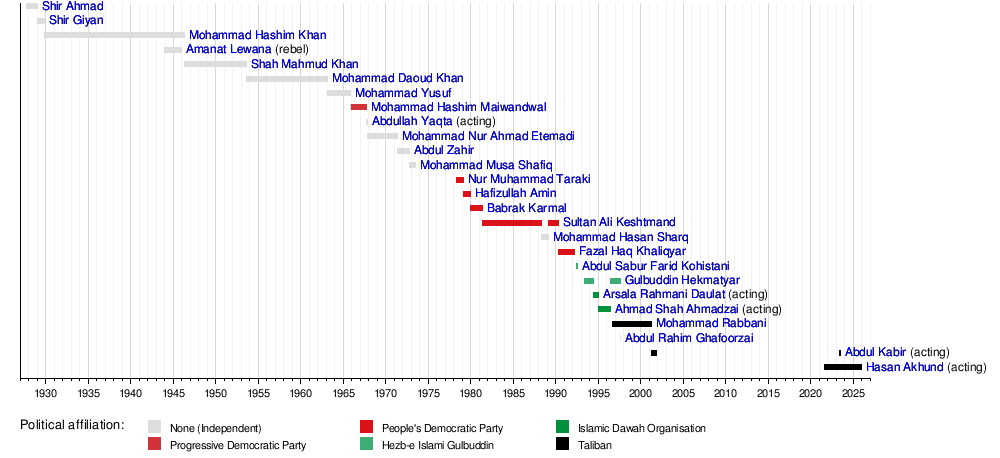
See also
 In Spanish: Primer ministro de Afganistán para niños
In Spanish: Primer ministro de Afganistán para niños
- Supreme Leader of Afghanistan
- President of Afghanistan
- List of heads of state of Afghanistan
- Chief Executive (Afghanistan)
- Deputy Prime Minister of Afghanistan


